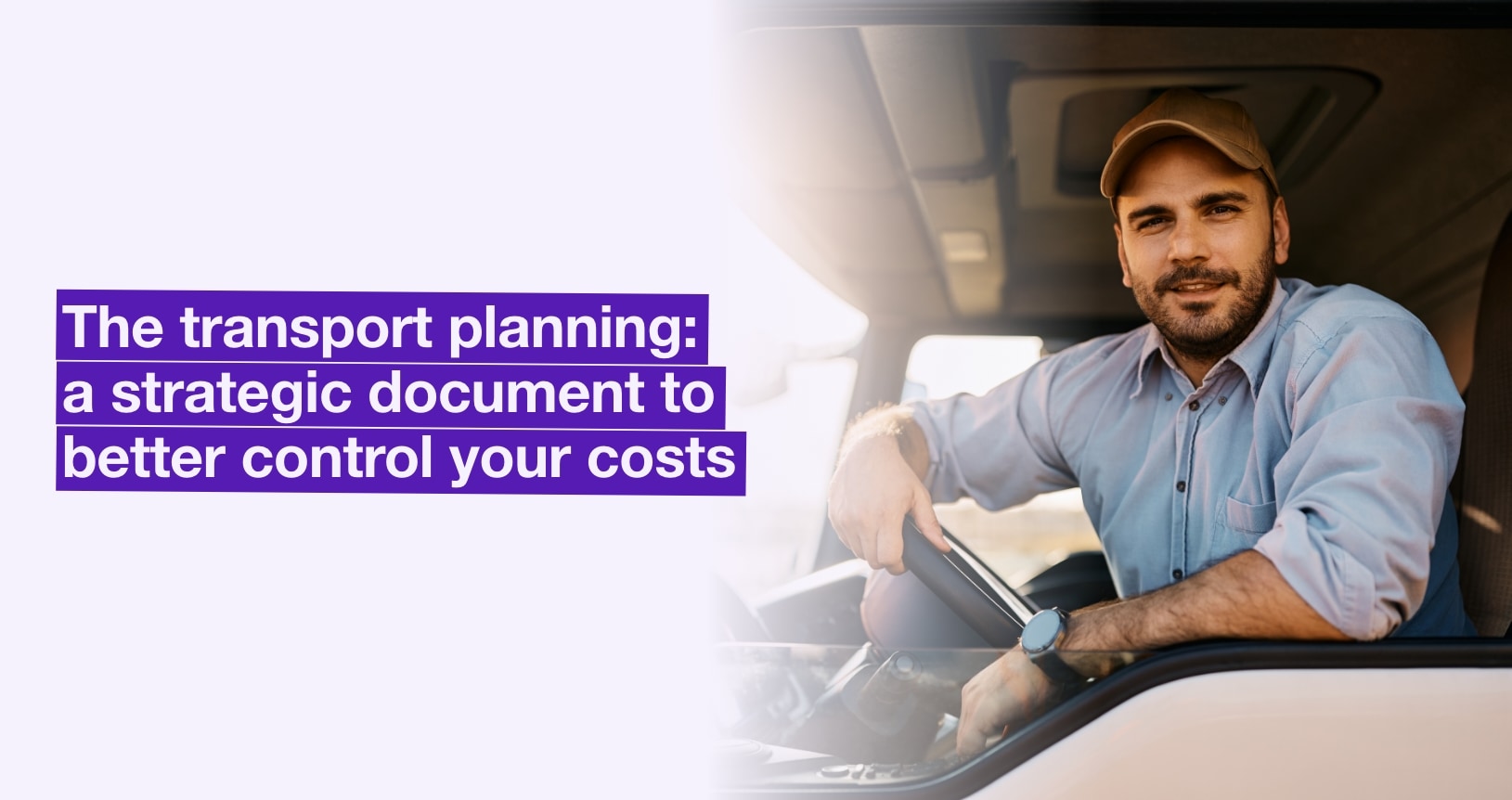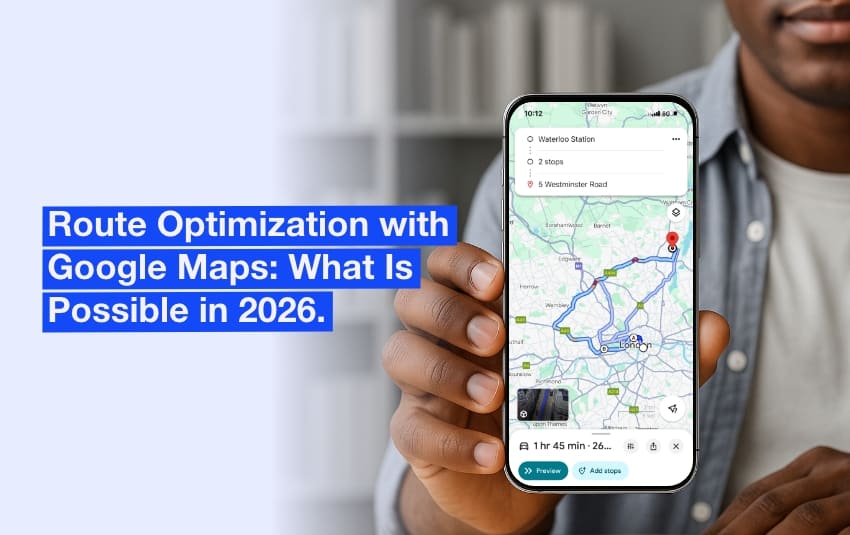The transport planning: a strategic document to better control your costs
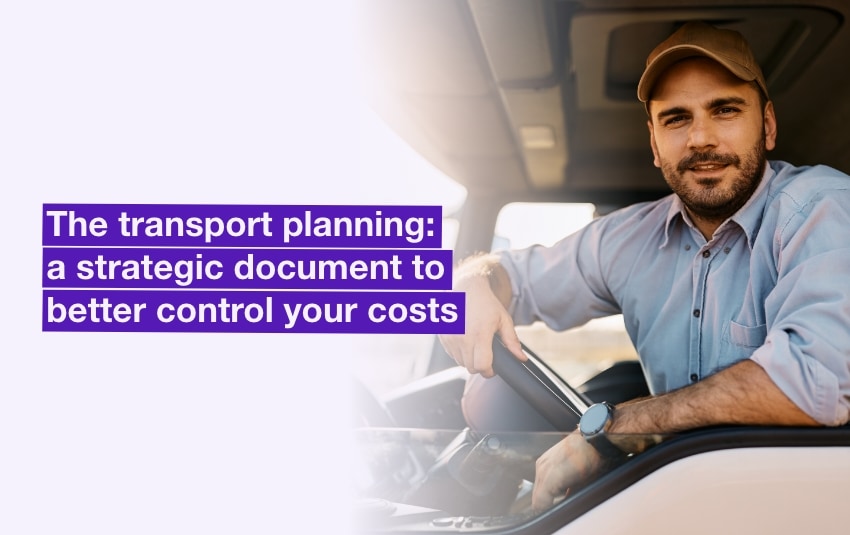
Are you looking for workable solutions to reduce costs, maximize vehicle loading or reduce the number of returns to the warehouse to reload? Have you already thought about the transport planning?
Too often overlooked or badly implemented, it is nevertheless very useful for objectively analyzing your logistics organization and successfully developing it.
Let’s take a look at this essential tool for optimizing the human and material resources that you have.
Table of contents
- What is a transport planning?
- Who is using this type of document?
- What information should a transport planning contain?
- The benefits of an optimized transport planning
- 5 steps to implement a relevant transport planning
The transport planning or plan is an essential strategic document for reducing costs. Its optimisation enables vehicle loading to be maximised and the number of returns to warehouse to be reduced. For transportation managers, it is an essential tool for strengthening their logistics organisation.
What is a transport planning?
The transport planning is a strategic document designed to optimize all or part of a company’s logistics flows, whether they are carried out by your teams or outsourced to a subcontractor.
For each route, it lists the best available solution for getting customers or goods from point A to point B.
In concrete terms, this document can take the form of a map, an XXL spreadsheet or a roadmap including all scheduled routes.
In practice, the paper transport planning has almost disappeared. Some small companies with fairly basic logistics continue to manage with Excel spreadsheets.
But the management of routes has become such a complicated task that the use of a TMS (Transport Management System) software is often required.
These solutions are now essential to centralize and analyze all relevant data, and help you make the best decisions.

The transport planning optimizes company’s logistics flows
Who is using this type of document?
In everyday life, we have all checked the transport planning provided by Virgin Trains, Great Western Railway (GWR) or Thameslink, in particular to check the timetable of trains or buses running on public holidays.
However, the transport planning used by businesses is much more precise!
All the stakeholders wishing to improve the management of their human and material resources have an interest in having such a plan:
- Public transport operators
- Road transport operators
- Manufacturers or retailers running an online shop
- Express operators, etc.
What information should a transport planning contain?
An operational transport planning lists all the routes made over a given time period, indicating for each of them the essential information:
- The starting and ending addresses, as well as any intermediate stops on the route: logistics hub, warehouse, parcel pick-up point, etc.
- The date, timetable or expected duration.
- The nature, weight, or volume of the goods to be carried.
- The type of vehicle used for each route, or each section of the network in the case of multimodal transport: HGV, van, temperature-controlled van, rail freight, etc.
- The name, qualification, or license of the driver.
In addition to this basic information, most TMSs include optional or customizable fields to add any data that is relevant to your industry: maximum delivery time, dangerous goods, loading dock number, etc.
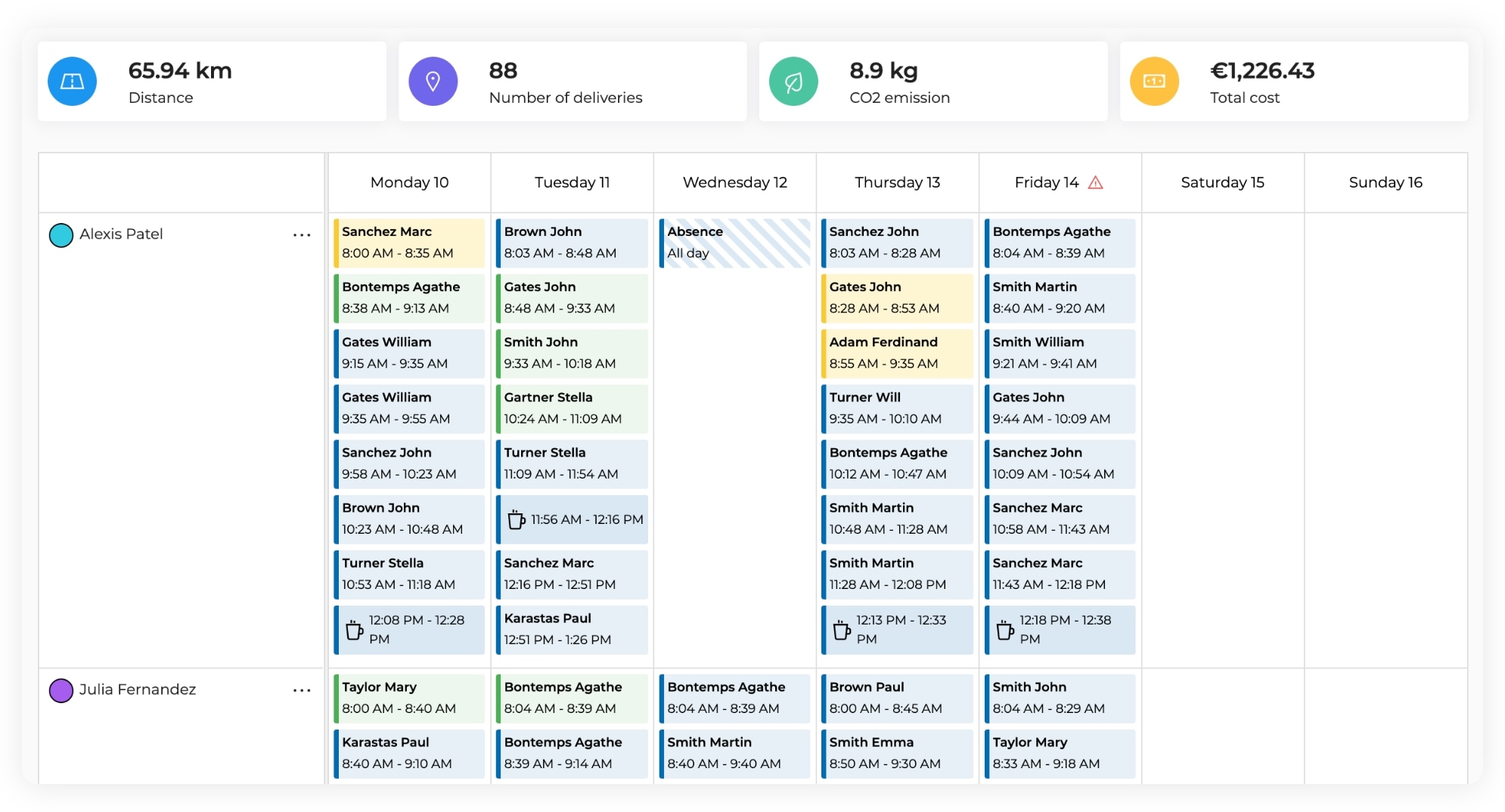
Transport planning in AntsRoute.
The benefits of an optimized transport planning
If implemented correctly, the transport planning will help you to optimize all the logistics flows and costs. Depending on your objectives, the operation can result in material, human and environmental benefits.
More efficient use of freight vehicles
Do you carry goods for your own account or for your customers? Depending on your business and the delivery deadlines required, the implementation of a transport planning can result in :
- Reduction in the number of vehicles on the road.
- Optimization of the vehicle loading rate.
- Reduction in the number of miles travelled and therefore in the cost of fuel, tolls, etc.
On the contrary, if you subcontract some trips, this tool will provide you with strong and quantified arguments to compare the performances of the different transporters and pitch this out.
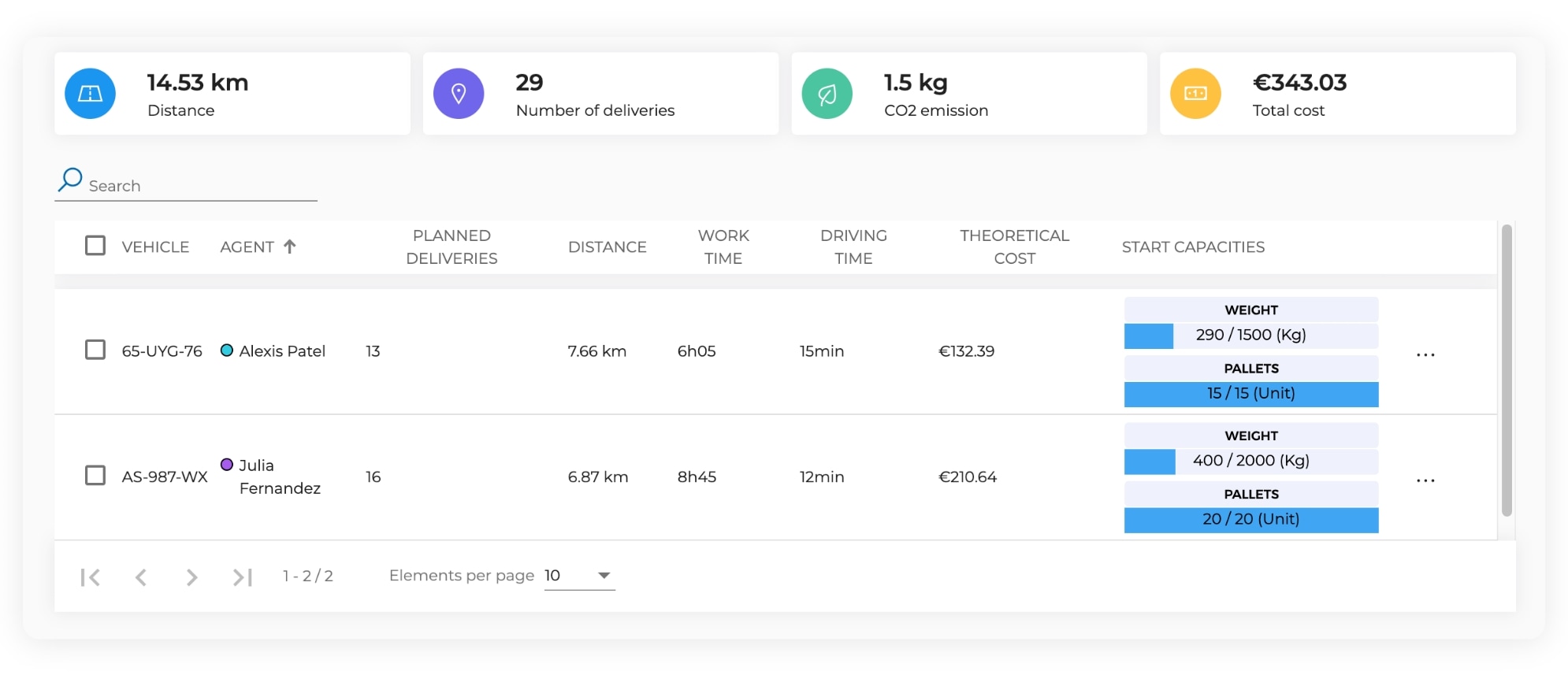
The optimization of the vehicle loading rate on AntsRoute.
Better management of human resources
The shortage of delivery drivers is here to stay. In response, an increasing number of companies are experimenting with different methods to retain current drivers and attract new ones.
However, a well-organized transport planning helps to reduce the stress of the drivers and helps to achieve a better balance between working time and rest time.
Reduction in CO2 emissions
This last point is particularly interesting for organizations that are concerned with their environmental performance, such as mission-driven companies and those that are committed to an eco-friendly approach.
The transport planning helps you find efficient solutions to limit your carbon emissions, such as grouping certain deliveries.
For companies that want to go even further, it is impossible to set up train-road or river-road deliveries without TMS software. Although multimodal transport has proved to be environmentally friendly, it nevertheless requires a flawless logistics organization!
5 steps to implement a relevant transport planning
1. List the key criteria in your industry
A feasible transport planning must take into account all internal and external criteria that may have an impact on the routes to be optimized:
- Material requirements, such as available loading or unloading docks, nature and weight of goods carried, delivery times, etc.
- Regulatory constraints, such as the type of license required, traffic restrictions, legislation on the transport of dangerous goods, etc.
- Available workers, taking into account break times, holidays, double staff for certain routes, etc.
- Data about vehicles in use, such as engine, load capacity, average fuel consumption, carbon footprint, etc.

The management of skills in AntsRoute.
2. Compare available IT solutions
Only after you have identified all the data to be collected and analyzed, you can choose the most relevant IT solution for your company.
Even if the use of a spreadsheet such as Excel looks attractive, it is better to choose a TMS software worthy of the name. There are hundreds of them available on the market today, tailored to the different supply chain activities: TMS for shippers, transporters, route optimization software, etc.
Most publishers offer either a free trial period for a few users or a test version with limited features.
In any case, give your team enough time to test each of the pre-selected solutions in a real environment. A well-chosen TMS from the start will save you a lot of time and money later on!
3. Communicate and edit the transport planning in real time
Today, transport software is increasingly available as SaaS (Software as a Service). In other words, they are accessible via any device connected to the Internet, in exchange for a monthly or yearly subscription.
Thanks to this online service, you can automate the sending of route plans to all stakeholders: drivers, customers, logistics platforms, etc.
This operating mode is all the more valuable in the event of a breakdown or accident on the road network, as you can adjust the transport planning in real time and send it instantly to the people concerned.
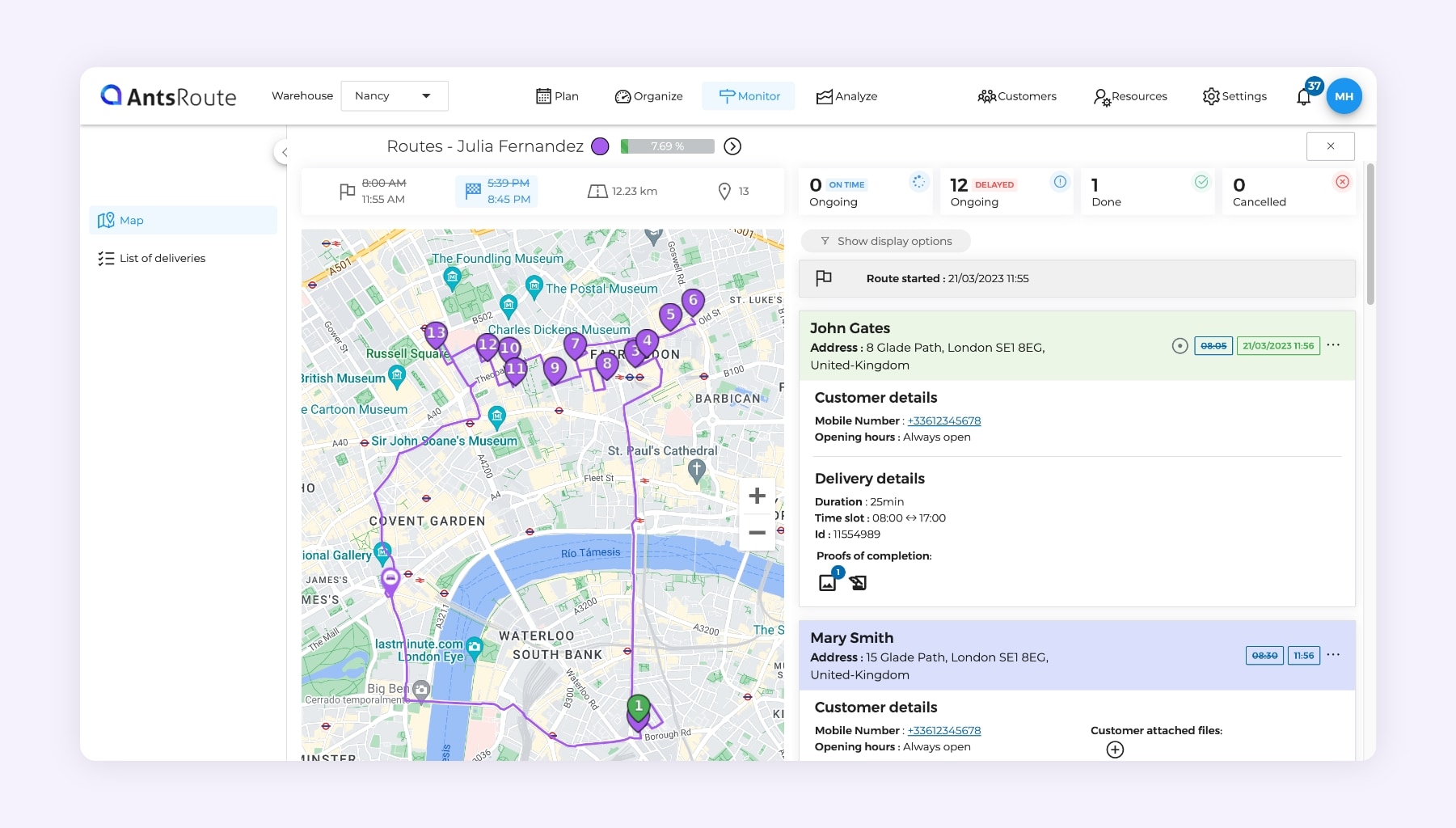
Live tracking of a route on AntsRoute software.
4. Analyze key indicators regularly
TMSs are very effective tools from an operational point of view, but they also provide transport managers with valuable indicators for constantly optimizing their logistics organization.
With AntsRoute software, you can, for example, view strategic data such as:
- The ratio of deliveries completed or cancelled.
- On-time service rate, i.e. deliveries completed on time.
- Miles travelled per day, per driver, etc.
- Statistics on the average cost per route and the total cost of routes.
- Average CO2 emissions per route or for all routes.
- Areas where your customers are concentrated, etc.
5. Optimize the transport planning continuously
This gives you all the information you need to understand the reasons for the difference between planned and achieved performance, and to draw the consequences for better resource allocation.
For example, if the same customer regularly receives late deliveries, the cause of the issue should be analyzed and the appropriate response provided.
Are the planned routes feasible? Are the delays due to a lack of organization by the client? Would it be better to deliver to this location at another time of the week to avoid traffic jams?
This in-depth analysis, to be carried out every week or month, will enable you to optimize your transport planning step by step. The figures show that sometimes painful decisions will have to be taken, such as renegotiating or ending some contracts.
But this work is a very effective way to get back on the road to profitability, and to build loyalty among your teams and your customers!
Do you manage a fleet of delivery or field service vehicles? AntsRoute is a very useful route optimization solution to improve your transport planning.
A simple form to fill in, and you can try our solution for free and without commitment for 7 days!
Free 7-day trial | No credit card required
Contenu
- What is a transport planning?
- Who is using this type of document?
- What information should a transport planning contain?
- The benefits of an optimized transport planning
- More efficient use of freight vehicles
- Better management of human resources
- Reduction in CO2 emissions
- 5 steps to implement a relevant transport planning
- 1. List the key criteria in your industry
- 2. Compare available IT solutions
- 3. Communicate and edit the transport planning in real time
- 4. Analyze key indicators regularly
- 5. Optimize the transport planning continuously


